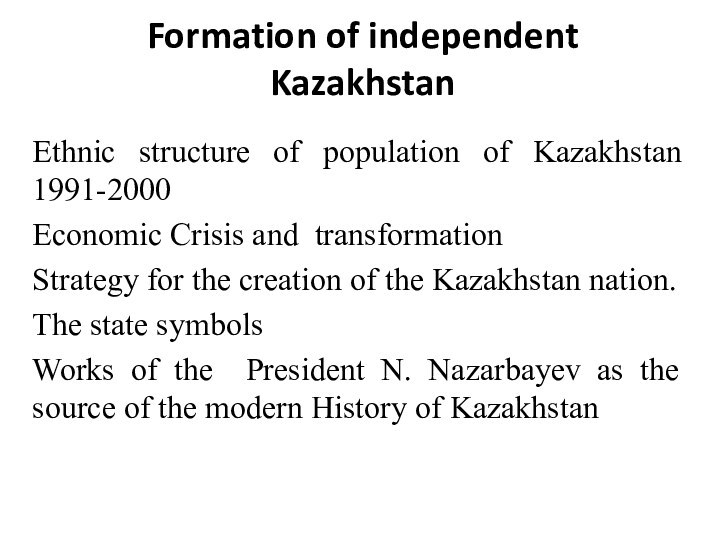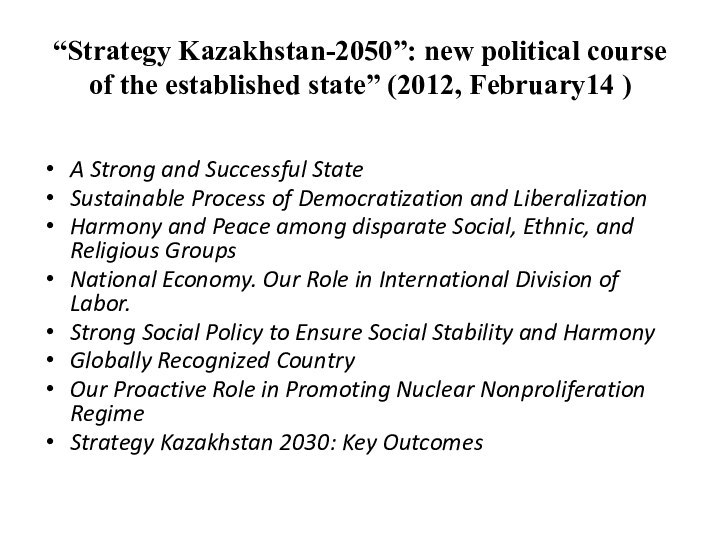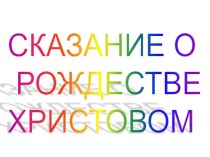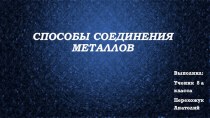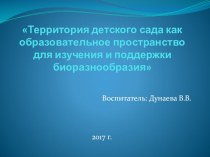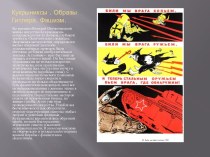Слайд 2
Literature
J.ROBERT BROWN, JR. Culture, chaos and capitalism: privatization
in Kazakhstan.1998
Aydingün, A. ‘State symbols and national identity construction
in Kazakhstan’. In The Past as a Resource in the Turkic Speaking World, ed. I.Bellér-Hann, 139-158.2008
Dave, B. Kazakhstan. Ethnicity, Language and Power. London: Routledge, 2007.
Diener, AC. ‘National territory and the reconstruction of history in Kazakhstan’. Eurasian Geography and Economics 43(8) (2002), 632–635.
Wimmer, A. ‘The making and unmaking of ethnic boundaries. A Multilevel Process Theory’. American Journal for Sociology 113(4) (2008), 970–1022.
Слайд 3
Glossary
Havoc –разрушение
Insolvency –банкростство
cease – прекращение
Crude - cырье
Слайд 4
Ethnic structure of population of Kazakhstan 1991-2000
In 1989,
shortly before independence, Kazakhstan had 16.46 million people, 39.7%
of which were Kazakh, 37.8% Russian, 5.8% Ukrainian, and 1.1% Belarussians. To compare, Turkmenistan and Uzbekistan were the most homogeneous. Turkmen made up about 77% of Turkmenistan, Uzbeks about 74% of Uzbekistan. Even Kyrgyzstan was more than half Kyrgz. Kazakhstan became the only republic of the U.S.S.R. where the indigenous population was not in the majority.
Independence brought a number of disruptions, including a massive wave of emigration Significant numbers of non-Kazakhs, particularly Russians and Germans, left the country. Through the end of 1996, the population of Russians had decreased by 800,000, and more than 500,000 Germans had emigrated.
Слайд 5
Shortly after independence, the percentage of ethnic Russians
was placed at about 37%, with ethnic Kazakhs at
about 42%. By 1997, the percentage of Kazakhs had crossed 50% and the percentage of Russians had fallen to 32%. By contrast, they constituted about 8% in Uzbekistan and 7% in Turkmenistan. Only in Kyrgyzstan the Russian population was substantial, amount of about 22%.
From this data Politicians in the Duma and prominent Russians, such as Solzhenitsyn, occasionally called for the reunification of all or part of Kazakhstan with Russia.
Слайд 6
The language situation in Kazakhstan
The position of Russian
in Kazakhstan was unique in Central Asia. Linguistically, Kazakhstan
was the most russified of all the Central Asian republics
Russian had largely supplanted Kazakh as the most widely spoken local language. Russian was widely spoken in the region. It was necessary to know the language to participate in government or to communicate with the Russian population. Communication within each ethnic group, however, tended to take place in that group's native language
Слайд 7
Language emerged as an important issue immediately upon
independence.
Independence created a new situation in which the Republic
was freed from many pressures from Moscow . The young statewas in need to define itself, because of the political position it found itself in. As in all the other former Soviet republics, the nation wanted to reassert its culture and identity.
The most important step could be the introduction of Kazakh at all levels of the educational system.
The constitution of Kazakhstan, adopted in 1995, designated Kazakh as state language of Republic of Kazakhstan
Слайд 8
The efforts to establish the new ethnic relations
in Kazakhstan, turned to what was labeled a process
of kazakhization. Kazakhization was the process of ascendancy of Kazakhs as a national group on the expense of other national groups, mainly Russians. This process was perceived by many Kazakhs as a way to “pay back” for the years of Russian domination.
Another area where kazakhization become visible, is the ethnic composition of the state power apparatus. Between the years 1985 and 1994 the non-Kazakh proportion of the high level positions fell sharply from 50% to 25%. In 1994, 74% of state apparatus was ethnically Kazakh, although Kazakh representation in the population was 44%. The numbers for Slavs were correspondingly 23% in the state apparatus and 43% in general population
Слайд 9
Economic Crisis: reasons
The most immediate consequence of independence
was economic havoc.
Kazakhstan's economy needed to reorient itself away
from Russian economy and Russian markets. The country had a rich natural resource but had underdeveloped processing industry. In the Soviet era, the country produced 20% of the country's coal. Kazakhstan ranked fourth in gold reserves, behind only South Africa, Russia and the United States. It had as much copper as Chile, and some of the world's largest deposits of lead and zinc. Most significantly Kazakhstan contained prodigious amounts of untapped oil and gas.
Слайд 10
The government had difficulty paying even those small
pensions. Most people, particularly those in rural areas, remained
poor, aintaining a subsistent existence.
Companies confronted a cash crisis. They had the choice of ceasing production or continuing to sell goods, but with marginal prospects of payment. The banking system rested on the edge of insolvency.
Слайд 11
Economic Transformation
Privatization began in 1991. The government created
a State Committee on Privatization ("Gos Kom Imuvshestva" or
"GKI") and gave it responsibility for disposing state-owned businesses. Officially referred to as the Program of Denationalization and Privatization, but more informally called "spontaneous privatization," the early efforts were unsystematic and nontransparent."
They generally involved transfers of small or medium sized businesses to insiders (managers and employees), although the government often retained a minority interest. In general, spontaneous privatization involved government-owned businesses that formed joint stock companies ("JSCs") and distributed shares to employees and management. Examples included Merei JSC (furniture), Kyz-Zhibek JSC (textiles), and Rakhat JSC (candy).
Слайд 12
Privatization
With more than 7,000 enterprises privatized by 1993,
the total number sounded deceivingly impressive. It represented only
a small part of Kazakhstan's industrial base. Moreover, the legal regime was inadequate, and companies still owned their social assets.
Systematic efforts at privatization only began in 1993. The Second National Program of Denationalization and Privatization was promulgated on March 3, 1993. In setting out the scheme, the program divided businesses slated for sale not on a functional basis, but rather, by the number of employees. Divided into three segments, the process would include small scale privatization (asset sales and businesses with less than 200 employees), mass privatization (enterprises with between 200 and 5,000 employees, with strategic industries omitted), and case-by-case privatization of large and strategic enterprises
Слайд 13
Privatization investment funds
Coupons could only be contributed to
privatization investment funds ("PIFs") Coupon privatization resulted in the
creation of 170 PIFs." The largest, in terms of the coupons collected, included Butya, Auyl, Altynden, Kuat-Capital, and Natsionalniy.
The privatization process had resulted in the sale of at least 51% of each company's shares to the PIFs, with the government typically retaining the remaining 39% and employees receiving a 10% block of nonvoting shares
Слайд 14
Privatization could take place through the sale of
shares, the sale of assets, or through the execution
of management contracts. Initial efforts focused on cash purchases. Philip Morris acquired 88% of Almaty Tobacco Company in late 1993 for $300 million.
Coca- Cola opened a bottling plant in Almaty in May 1996. They established strong positions in the country.
Daewoo purchased a 40% interest in Kazakhtelekom for $100 million.
In the spring of 1997, the Chinese National Oil Company paid $325 million for a 60% interest in Aktobemunaigas.
The 1995 agreement signed by JapanChrome to manage Kazchrome illustrated how management contracts worked in practice
Слайд 15
Strategy for the
creation of the Kazakhstan nation.
Important in
understanding Kazakhstan’s boundary-making strategy are also linked to Kazakhstan’s
diplomatic ties to the homelands of its non-Kazakh ethnic groups, of which Russia is the most important (ethnic Russians are the second-largest ethnicity in Kazakhstan)
Kazakhstan is also keep to preserve the image of interethnic and interreligious peace within its state boundaries.
Слайд 16
The Kazakh nation and the Kazakhstani nation.
This
was especially manifest in the two Republic of Kazakhstan
constitutions of 1995 and 1993. When the 1993 constitution was replaced by the 1995 constitution the preamble also changed.
The new preamble emphasized the ethnic Kazakh nation: “We, the people of Kazakhstan, united by a common historic fate, creating a state on the indigenous Kazak land […]” (Constitution of the RK, 1995:). Here, the “people of Kazakhstan”, which includes all ethnic groups and national minorities was included. The ethnicity-based concept on territoriality was introduced.
Слайд 17
The preamble of the 1993 constitution had :
“We, the people of Kazakhstan, as an inseparable part
of the world community, take the unshakeable Kazakh statehood into our consciousness..” . Here, Kazakh statehood is referred to as an abstract idea and there is no mention of Kazakh indigenous territories.
This change in the preamble of the constitution lays the foundation of the concept of Kazakhstan as the homeland of ethnic Kazakhs.
Слайд 18
Kazakhstanian
President Nazarbayev introduced first the term ‘Kazakhstani’ in
his speech on the strategy programe“Kazakhstan – 2030” in
1997. He asked : “Today not everybody can answer the seemingly simple question: ‘Who are we – the Kazakhstanis?’
This idea—that the Kazakh group is the ‘stateforming nation’, next to the Kazakhstani nation which comprises the ‘people of Kazakhstan’—has been repeated many times by President Nazarbayev.
the term “Kazakhstanian” means the civic nation, which includes all groups inherent within Kazakhstan’s territory. The idea was to justify the ethnopolitical foundations of Kazakhstan.
Слайд 19
The state symbols
The state symbols in Kazakhstan are
representative of the Kazakh ethnopolitical basis of the state.
The statue of Lenin in Almaty’s centre was replaced with a statue of the Golden Warrior, a mythical figure that roots Kazakhs identity as far back as the third century B.C.
Furthermore topographic names—mostly Soviet street and town names—were replaced with Kazakh names, which symbolically nationalized the state by bringing its Kazakh ethnopolitical to the fore.
Слайд 20
The national flag
The three state symbols of Kazakhstan—the
national flag, the national emblem and the national anthem—
were created upon independence. The national flag represent the Turkic Khanate which was present in Kazakh territories. An eagle is depicted in the middle of the flag under a sun with sunrays, and the left side is decorated with traditional Kazakh ornaments.
The eagle represents the life of ethnic Kazakhs in the steppes, where falconry is a traditional and highly respected sport. The flag of Kazakhstan has no religious symbols
Слайд 21
The Assembly of People of Kazakhstan
According to the
census of 2009, 63.1% of the population are ethnic
Kazakhs and 23.7% are Russian. Rather than homogenizing the population and assimilating it within the Kazakh nation, Kazakhstan chose a different path. Assimilation is not regarded as an option, an alternative is to draw boundaries between national minorities and national majorities, boundaries between ethnic groups
The Establishment of the Assembly of People of Kazakhstan in 1995 demonstrated policy of Kazakhstan. De jure, it is a nongovernmental organization, chaired by President Nazarbayev.
Слайд 22
Works of the President N. Nazarbayev as the
source of the modern History of Kazakhstan
As President of
the new independent nation state of Kazakhstan, Nazarbayev published more than 20 books.
All books of Nasarbaev reflect the different stages of independent Kazakhstan, including the preparation of Development ‘Strategy 2030’, the process of adoption of the Constitution, the discovery of hydrocarbon resources, the introduction of national currency, tenge, and the creation of the bank system”.
Nasarbaev devoted to Special attention to Astana as “New capital of a new era”.
Слайд 23
Why do we consider Nazarbayev's book as a
historical source of independent Kazakhstan?
First of all, As
President of the new independent nation state of Kazakhstan, Nazarbayev had to wrestle with extraordinary crises.
Second Nasarbaev led Kazakhstan from Communism towards privatisation and free markets. In these turbulent years the discovery of huge oil and gas riches in the Caspian gave a massive boost to the economy.
Third Nazarbayev is the initiator of reforms in Kazakhstan and signed by all the historical documents
Слайд 24
Kazakhstan: Without rights and lefts. (1991)
This
work is written in 1991 when was proclaimed independence
Kazakhstan. And in this functioning and working the reflected thought Nazarbaev about development independent of Kazakhstan.
Слайд 25
On the eve of XXI century (1996)
Why the
title of the book is called like this?
Because in
this time the Republic of Kazakhstan stood by the door XXI century.
In front of the country stood new transformations.
Слайд 26
Kazakhstan-2030
The long-term development strategy "Kazakhstan-2030: Prosperity, security and
improved living standards for all Kazakhs" was adopted in
1997. It identified 7 priorities for the country's development.
Priority 1: National security
Priority 2: Domestic stability and social cohesion
Priority 3: Economic growth
Priority 4: Health, education and welfare for the citizens of Kazakhstan
Priority 5: Energy resources
Priority 6: Infrastructure, transport and communications
Priority 7: A professional State
Слайд 27
In the flood of history (1999)
The book name
is connected with long-term history of an origin of
the Kazakh people. In a history stream the part of history and integral means. In other words history of Kazakhs since ancient times and to the present. It is possible to tell that in the book name all its essence is concentrated
Today all these problems are carried out by means of the program "Cultural heritage". Many historical monuments are restored and along with it there are all new and new finds
Слайд 28
The critical decade (2003)
Nazarbaev tried to consider
the 5 most important issues :
The Caspian region
International terrorism
Religious extremism
Drug abuse
National security.
Слайд 29
In the heart of Eurasia (2005)
Тhis book will
be interesting not only for contemporaries, but also for
future generations, history of Astana is a history of independent Kazakhstan.
According to the president,, Astana should be not only an administrative center in Kazakhstan, but also a city of science, education, culture and high technology, as well as the bridge between Europe and Asia.
Слайд 30
Address of the President of the Republic of
Kazakhstan,
Nursultan Nazarbayev to the People of Kazakhstan
( 1997-2013)
At
the first stage of the address reflected the particular reforms in Kazakhstan, in the circumstances of the transit period and out of the crisis.
In the second stage, they specified the tasks move forward, sustainable economic growth.
On the third - on the basis of real possibilities have been identified important economic and social priorities, which are decisive in the present.
The fourth and latest, phase of the main priorities of development of Kazakhstan until 2020.
